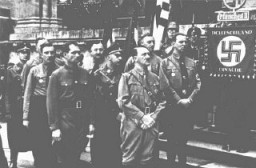You searched for: 交易所项目快速搭建【TG���������@EK7676】平台包网搭建交易所项目快速搭建【TG���������@EK7676】平台包网搭建9CPeC8oqbn
<< Previous | Displaying results 61-70 of 299 for "交易所项目快速搭建【TG���������@EK7676】平台包网搭建交易所项目快速搭建【TG���������@EK7676】平台包网搭建9CPeC8oqbn" | Next >>
-
Pages of Hebrew prayer books damaged during Kristallnacht
ArtifactThe pages photographed here are from Hebrew prayer books destroyed during the Kristallnacht ("Night of Broken Glass") pogrom of November 9 and 10, 1938. These pages were damaged by fire during the destruction of the synagogue in Bobenhausen, Germany. The Jewish community of Giessen donated them to the United States Holocaust Memorial Museum in 1989.

-
Portrait of Victoria and Isak Assael
PhotoPortrait of Victoria and Isak Assael, the daughter and son of Shabetai Assael. They were students and lived at Sremska 9 in Bitola. This photograph was one of the individual and family portraits of members of the Jewish community of Bitola, Macedonia, used by Bulgarian occupation authorities to register the Jewish population prior to its deportation in March 1943.
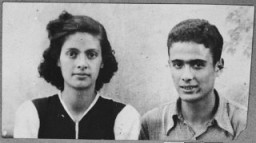
-
The judges at the Doctors Trial
PhotoAmerican judges (top row, seated) during the Doctors Trial, case #1 of the Subsequent Nuremberg Proceedings. Presiding Judge Walter B. Beals is seated second from the left. Nuremberg, Germany, December 9, 1946–August 20, 1947.
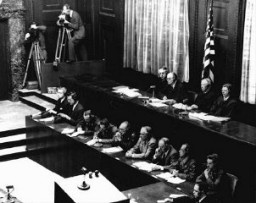
-
Otto Ohlendorf on trial
PhotoOtto Ohlendorf, commander of Einsatzgruppe D (mobile killing unit D), during Trial 9 of the Subsequent Nuremberg Proceedings. This photograph shows Ohlendorf pleading "not guilty" during his arraignment at the Einsatzgruppen Trial. Nuremberg, Germany, September 15, 1947.
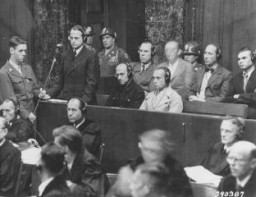
-
Jewish refugee ship Pan-York docks in Haifa
PhotoThe Jewish refugee ship Pan-York, carrying new citizens to the recently established state of Israel, docks at Haifa. The ship sailed from southern Europe to Israel, via Cyprus. Haifa, Israel, July 9, 1948.
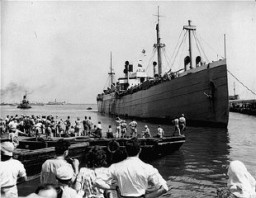
-
Insignia of the 95th Infantry Division
PhotoInsignia of the 95th Infantry Division. The 95th Infantry Division, the "Victory" division, gained its nickname from the divisional insignia approved in 1942: the arabic numeral "9" combined with the roman numeral "V" to represent "95." The "V" led to the nickname, since the letter "V" was universally recognized as an Allied symbol for resistance and victory over the Axis during World War II.
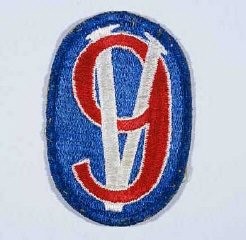
-
Dutch rescuer Semmy Woortman-Glasoog
PhotoSemmy Woortman-Glasoog with Lientje, a 9-month-old Jewish girl she hid. Woortman-Glasoog was active in a network which found foster homes, hiding places, and false papers for Jewish children. She was later named "Righteous Among the Nations." Amsterdam, the Netherlands, between 1942 and 1944.
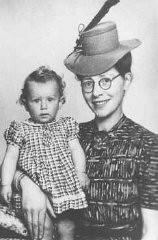
-
Synagogue in Oberramstadt burns during Kristallnacht
PhotoAs the synagogue in Oberramstadt burns during Kristallnacht (the "Night of Broken Glass"), firefighters instead save a nearby house. Local residents watch as the synagogue is destroyed. Oberramstadt, Germany, November 9-10, 1938.
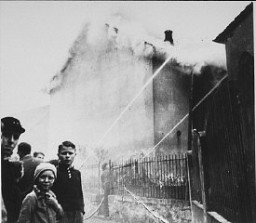
-
Retracing the route of the failed Beer Hall Putsch
PhotoAdolf Hitler, Julius Streicher (foreground, right), and Hermann Göring (left of Hitler) retrace the steps of the 1923 Beer Hall Putsch (coup). Munich, Germany, November 9, 1934.
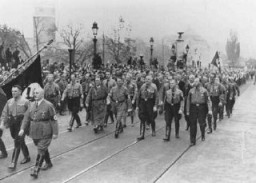
-
Celebration of the anniversary of Hitler's failed Beer Hall Putsch
PhotoAdolf Hitler and other participants in the Hitler Putsch, during the annual anniversary celebration of his failed attempt to seize power. Behind Hitler stand Rudolf Hess (left) and Heinrich Himmler. Munich, Germany, November 9, 1934.
